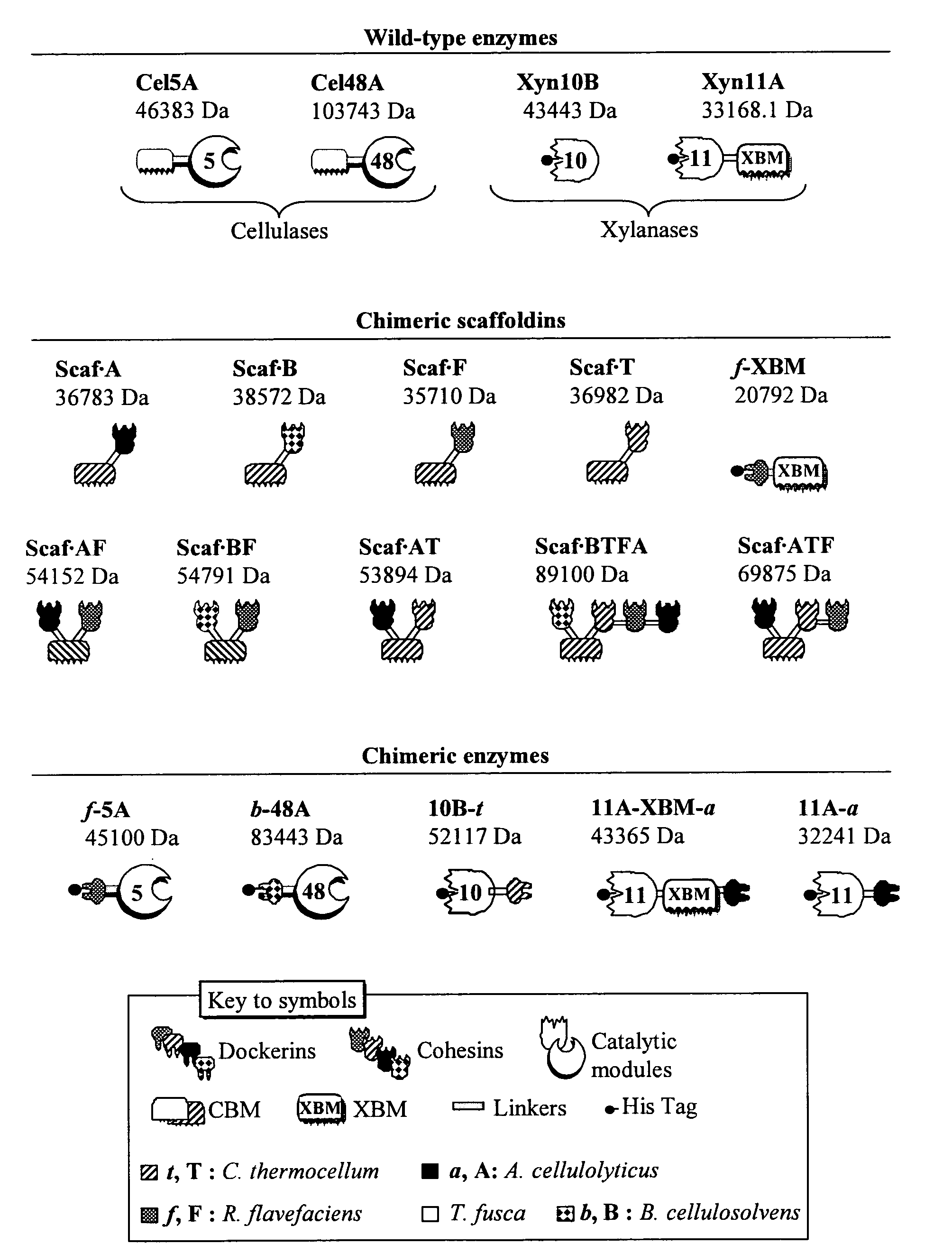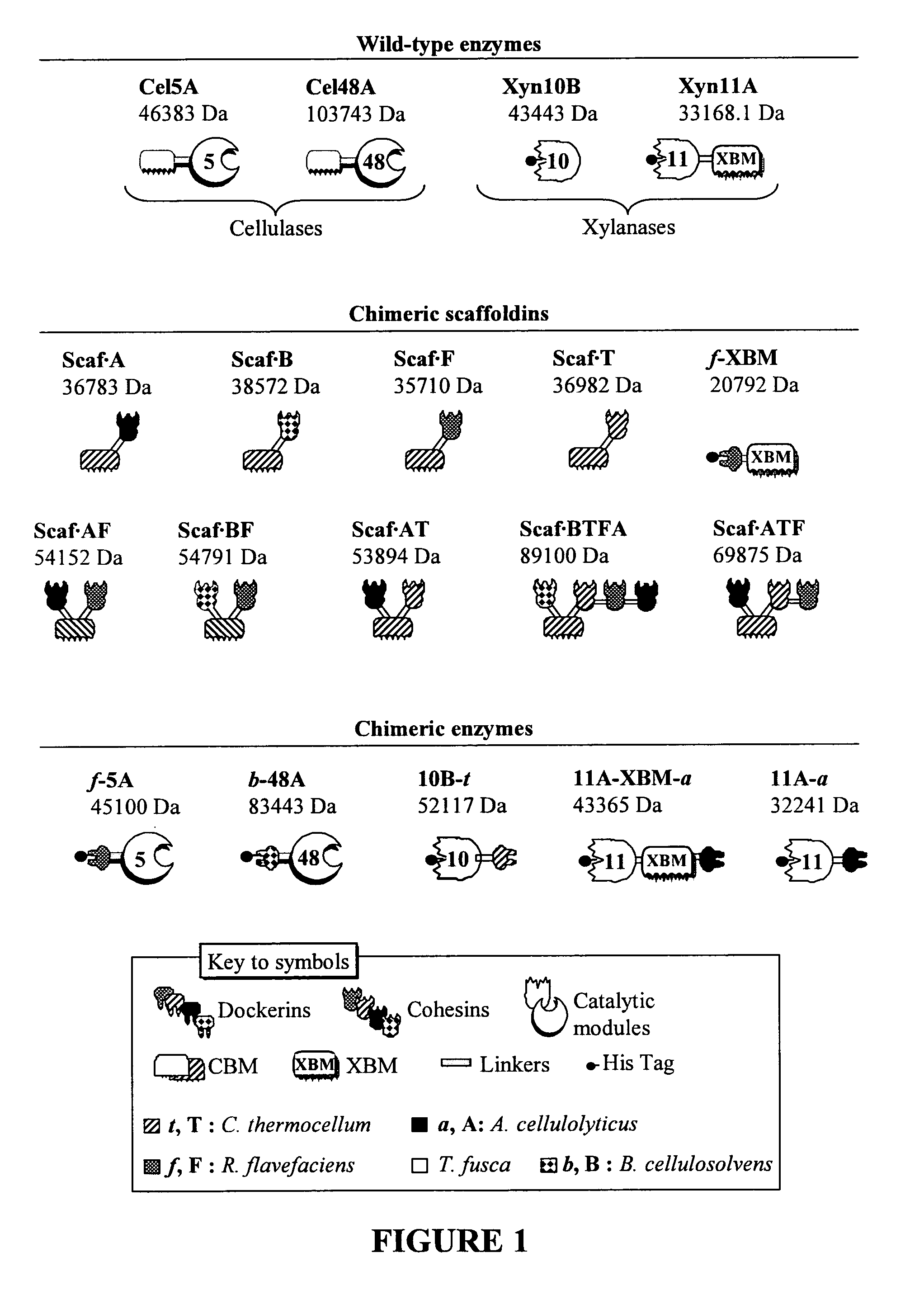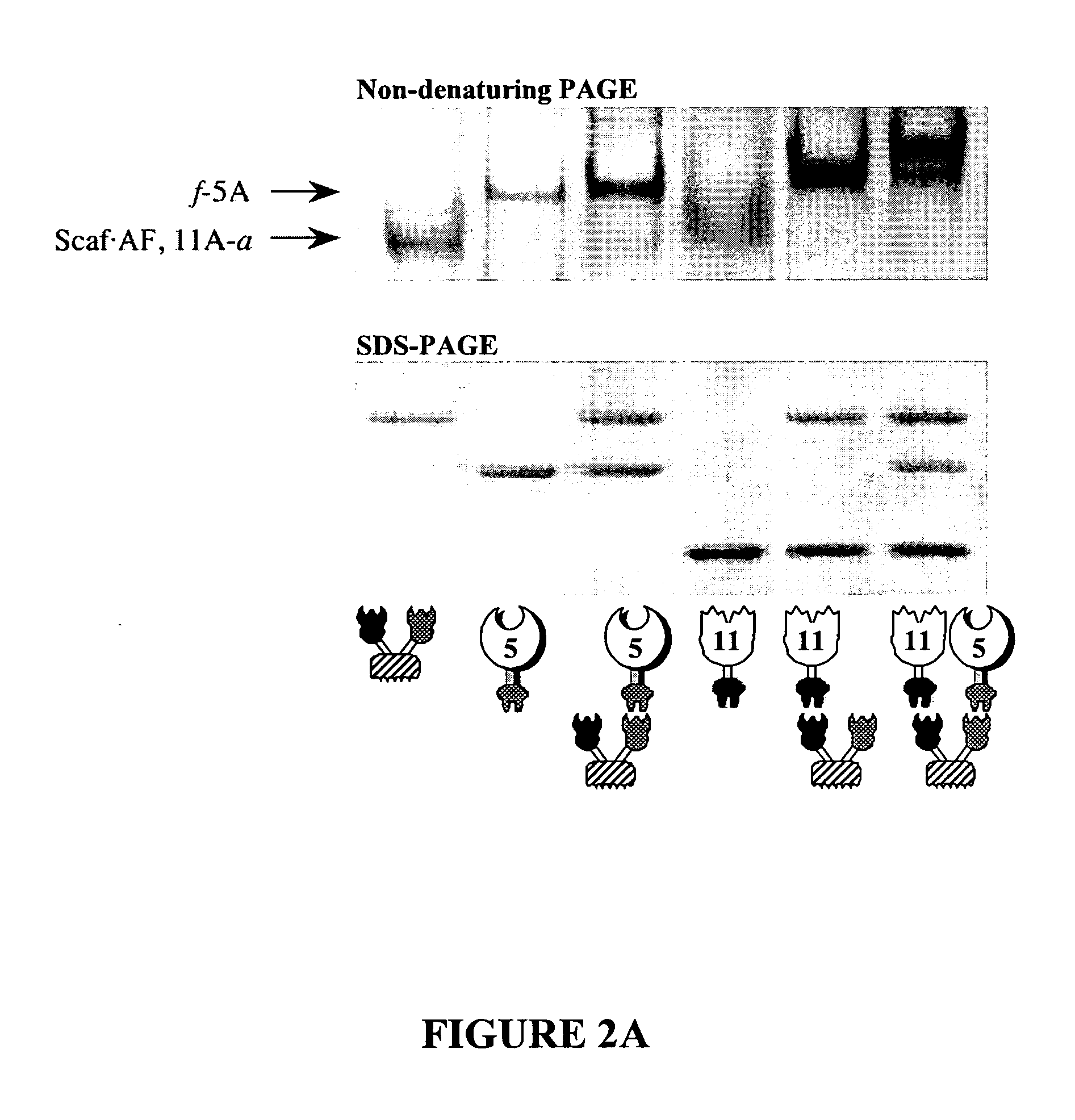Bio-engineered multi-enzyme complexes comprising xylanases and uses thereof
a technology of xylanases and complexes, applied in the field of bioengineered multienzyme complexes, can solve the problems of limited strategies involving multifunctional enzymes and cost-reducing approaches
- Summary
- Abstract
- Description
- Claims
- Application Information
AI Technical Summary
Benefits of technology
Problems solved by technology
Method used
Image
Examples
example 1
Construction And Expression of Recombinant Proteins
[0332]Methods
[0333]Cloning of Wild-Type Enzymes:
[0334]Plasmids encoding wild-type enzymes pCel5A, pXyn11A, pXyn10B, pCel48A were cloned as described in Irwin et al. 1994 Appl. Environ. Microbiol. 60:763-770; Irwin et al. 2000 Eur. J. Biochem. 267:4988-97; Kim et al. 2004 Can. J. Microbiol. 50:835-843. The sequences of the resulting polynucleotides and corresponding polypeptides are set forth in the following SEQ ID NOs:
[0335]Cel5A cloned wild-type: DNA—SEQ ID NO: 64; amino acids—SEQ ID NO: 65.
[0336]Xyn11A cloned wild-type: DNA—SEQ ID NO: 66; amino acids—SEQ ID NO: 67.
[0337]Xyn10B cloned wild-type: DNA—SEQ ID NO: 68; amino acids—SEQ ID NO: 69.
[0338]Cel48A cloned wild-type: DNA—SEQ ID NO: 84; amino acids—SEQ ID
[0339]NO: 85.
[0340]Cloning of Chimeric Enzymes:
[0341]The recombinant pf-5A was engineered as reported in Caspi et al. 2009 Appl. Environ. Microbiol. 75:7335-7342. The sequences of the resulting polynucleotide and corresponding p...
example 2
Interaction Between Scaffoldin and Enzymes
[0394]Methods:
[0395]Affinity-Based ELISA:
[0396]The matching fusion-protein procedure of Barak et al. 2005J. Mol. Recogit. 18:491-501; and Caspi et al. 2006 Biocat. Biotransform. 24:3-12. was followed to determine cohesin-dockerin specificity.
[0397]For example, for the analysis of dockerin-containing xylanases:
[0398]Analysis of Divergent Dockerins Using Immobilized Cohesins:
[0399]MaxiSorp ELISA plates (Nunc A / S, Roskilde, Denmark) were coated overnight at 4° C. with predetermined concentrations (designated below) of the desired CBM-Coh (100 μl / well) in 0.1M sodium carbonate (pH 9). The following steps were performed at room temperature with all reagents at a volume of 100 μl / well. The coating solution was discarded and blocking buffer (TBS, 10 mM CaCl2, 0.05% Tween 20, 2% BSA) was added (1 h incubation). The blocking buffer was discarded, and incremental concentrations of the desired XynDoc constructs, diluted in blocking buffer, were added. ...
example 3
Binding to Insoluble Polysaccharides
[0407]Method
[0408]Insoluble xylan was prepared by boiling oat-spelt xylan (Sigma Chem. Co., St. Louis, Mo.) for 30 min in distilled water and recovering the residue by centrifugation; this was followed by 3 washes with distilled water, and its dry weight was determined. Microcrystalline cellulose (Avicel) was purchased from FMC Biopolymer (Philadelphia, Pa., USA). The binding of each protein to insoluble polysaccharides (insoluble xylan from oat spelt and microcrystalline cellulose) was determined qualitatively using SDS-PAGE. Pure protein (10 μg for xylan binding assays and 5 μg for cellulose binding experiments in 50 mM citrate buffer pH 6.0, 12 mM CaCl2, 2 mM EDTA) was mixed with 0.5 mg of insoluble xylan or 10 mg of microcrystalline cellulose, in a final volume of 100 μl. Tubes were incubated on ice for 1 h with gentle mixing before being centrifuged at 14000 rpm for 1 min, and the supernatant fluids (containing unbound protein) were carefully...
PUM
| Property | Measurement | Unit |
|---|---|---|
| Time | aaaaa | aaaaa |
Abstract
Description
Claims
Application Information
 Login to View More
Login to View More - R&D
- Intellectual Property
- Life Sciences
- Materials
- Tech Scout
- Unparalleled Data Quality
- Higher Quality Content
- 60% Fewer Hallucinations
Browse by: Latest US Patents, China's latest patents, Technical Efficacy Thesaurus, Application Domain, Technology Topic, Popular Technical Reports.
© 2025 PatSnap. All rights reserved.Legal|Privacy policy|Modern Slavery Act Transparency Statement|Sitemap|About US| Contact US: help@patsnap.com



